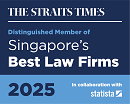Introduction
1. With effect from 23 May 2017, the provision in the Companies (Amendment) Act 2017 (the “Act”) became operative. The modifications to the Companies Act come as part of Singapore’s push to become an international choice of forum for debt-restructuring, by bringing its insolvency laws in line with Chapter 11 of the US Bankruptcy Code. The new regime now offers greater options and flexibility in restructuring tools available to both local and foreign distressed companies.
2. Alongside the amendments to the Act, the following subsidiary legislations were also introduced to deal with exclusions from regimes. Notably, these are:-
- The Companies (Prescribed Companies and Entities) Order 2017, which lists categories of entities that are excluded from the new scheme of arrangement and judicial management regimes; and
- The Companies (Prescribed Arrangements) Regulations 2017, which lists types of security interests that remain protected from the new scheme of arrangement and judicial management regimes.
3. This article will examine the key changes in relation to the following:-
- The new framework for schemes of arrangements;
- Enhancements to judicial management; and
- Cross-border restructuring and insolvency
Key Amendments
A. New Framework for Schemes of Arrangement
4. Four main changes have been made to the scheme regime under Sections 211A to 211I of the Companies Act, namely:-
(i) Enhanced creditor moratoriums;
(ii) Pre-packaged schemes;
(iii) Cross-class cram downs; and
(iv) Rescue financing.
(i) Enhanced Creditor Moratoriums
5. The Act functions to extend the scope of moratoriums which a Singapore court may order to cover the following:
- Pre-application moratoriums are now available, whereby companies may apply for moratorium where it proposes or intends to propose a scheme – an option previously only available under common law.
- An automatic 30-day moratorium will come into effect from the time an application for leave to convene a meeting of creditors is made. The Act further allows a moratorium to have worldwide or extraterritorial effect where creditors are subject to the “in personam” jurisdiction of the Singapore Courts. This also extends the imposition of moratoriums on proceedings of subsidiaries, where (pursuant to s 211C(2)(b) of the Companies Act) the subsidiary “plays a necessary and integral role in the compromise or arrangement, proposed by the holding company”.
- Where a moratorium is granted in relation to a company, related entities such as the subsidiaries or holding companies may, if necessary, also apply for a moratorium.
6. It is pertinent to note that where a moratorium may have disproportionately adverse effects on certain transactions (e.g. contractual set-offs and netting arrangements), carve-outs from the moratoriums are provided, entitling a company, creditor or receiver of a company to make an application to court to vary or discharge the moratorium.
(ii) Pre-packaged Schemes
7. Pre-packaged schemes have been introduced to allow the fast-tracking of pre-negotiated schemes. The court may, subject to safeguards, approve a scheme of arrangement without any meeting of creditors in the following circumstances:-
- The debtor has provided creditors with a statement, accompanied by adequate information, explaining the effects and impact of the scheme on any material interest of the directors or indenture trustees;
- The debtor has provided adequate notice to each creditor meant to be bound by the scheme and duly published notice of the application for a pre-packaged scheme in the Gazette and at least one English local daily newspaper and sent a copy of the same to the Registrar;
- The Court is satisfied that had a meeting of creditors taken place, the scheme would have been approved by the requisite majorities.
8. In this regard, the new provisions thus drastically shorten the minimum scheme timeframe to 30-45 days from application. However, it is uncertain if there may be difficulties in obtaining recognition of the scheme in other jurisdictions, where it appears that sufficient procedural fairness has not been afforded to creditors.
(iii) Cram-down Provisions
9. The cram-down provisions found in Section 211H in the Act mirror the provisions of Chapter 11 of the US Bankruptcy Code, and empower the Singapore Courts to approve a scheme despite the presence of dissenting creditors. This is a crucial reform of the Act serving to prevent a situation where a minority dissenting class of creditors could unreasonably frustrate a timely restructuring that benefits the distressed company and creditors as a whole. After the amendments, a Singapore Court may approve a scheme where there are one or more dissenting classes of creditors subject, among other things, to the following conditions:-
- Requisite majority approval in number and value was obtained from the creditors (to be bound) present and voting at the scheme meeting; and
- The Court is satisfied that the scheme does not discriminate unfairly between two or more classes of creditors, and is fair and equitable to each dissenting class.
(iv) Rescue Financing
10. The purpose of introducing “super-priority” status for rescue financing under Section 211E is for incentivising and protecting both new and existing investors seeking to inject capital into a distressed company.
11. The relevant provisions mirror the Debtor-In-Possession financing provisions found in Chapter 11 of the US Bankruptcy Code in allowing Courts to grant “super-priority” status to rescue financing loans that are imperative for the survival of the distressed company, subject to certain requirements and protections for other creditors. As denoted from its name, having “super-priority” status ensures that these lenders are repaid ahead of other creditors in any subsequent liquidation. On the same point, lenders can also be granted security over both secured and unsecured assets with respect to any rescue finance.
12. By altering the risk profile of existing debts, super-priority rescue financing will allow lenders to provide working capital to troubled, yet still viable companies, which in turn will afford them liquidity to restructure.
B. Enhancements to Judicial Management (“JM”)
13. JM is a temporary court-supervised procedure where a company, unable to pay its debts, is managed by a judicial manager. The changes to Singapore’s JM regime chiefly relate to: –
(i) The revised insolvency threshold;
(ii) The availability of JM to foreign companies;
(iii) A judicial manager’s ability to apply for rescue financing; and
(iv) The removal of a creditor’s veto powers.
(i) Revised Insolvency Threshold
14. After amendment, the solvency threshold for making a JM application has been lowered, thus making it easier to apply for a JM order. Accordingly, where the other statutory criteria have been met, the court need only be satisfied that a company “is likely to become” unable to pay its debts, as opposed to the previous threshold where a company “is or will be” unable to pay its debts.
(ii) Availability of JM to Foreign Companies
15. In an effort to facilitate the resolution of cross-border insolvencies, this provision has been revised to increase accessibility for foreign debtors. The amendments will allow a foreign company with “substantial connection with Singapore” to be liable for winding up pursuant to the Companies Act and consequently, subject to the Court’s jurisdiction to be placed under JM or scheme, providing that they first meet the statutory criteria as set out under Section 351 of the Companies Act.
(iii) Judicial Manager’s ability to apply for Rescue Financing
16. Pursuant to Section 227HA, judicial managers may now apply to Court seeking an order that rescue financing be given super-priority, even where no scheme has been proposed. There were previously no such provisions empowering judicial managers to carry out the same.
(iv) Removal of creditor’s veto power
17. If a person who has appointed, or is entitled to appoint a receiver or manager pursuant to a security interest vetoes an application to place the company in JM, his or her objection will not automatically bar the application. They must further show that the prejudice to that person is “disproportionately greater” than that caused to unsecured creditors if the application is dismissed.
C. Cross-Border Restructuring and Insolvency
18. The new provisions relating to cross-border insolvency were introduced with the objective of improving the recognition of foreign insolvencies in Singapore, and consequently expand recognition and enforcement of Singapore restructurings abroad. The key changes are: –
(i) The adoption of UNCITRAL Model Law on Cross-Border Insolvency (the “Model Law”);
(ii) Implementation of Judicial Insolvency Network (“JIN”) guidelines;
(iii) Singapore Court’s jurisdiction over foreign debtors / statutory codification of COMI Principles; and
(iv) The abolition of ring-fencing provisions.
(i) Adoption of UNCITRAL Model Law on Cross-Border Insolvency (the “Model Law”)
19. The Model Law provides a structured framework of rules for insolvency cases. The implementation of the Model Law, albeit with some modifications, will play an integral role in bringing about clarity and cooperation in resolving cross-border insolvencies locally. More importantly, it will improve the recognition of foreign insolvencies in Singapore, and expand recognition and enforcement of Singapore restructurings abroad through mutual recognition of insolvency orders and empowering the Court to give reciprocal aid in insolvency proceedings.
20. Foreign companies having assets and/or operations in Singapore, and subject to insolvency proceedings, will also be able to obtain the assistance and cooperation of Singapore courts in administering their assets more easily.
(ii) Implementation of JIN Guidelines
21. In October 2016, the Singapore Courts announced the establishment of a network of insolvency judges from several jurisdictions to encourage communication and cooperating amongst national courts i.e. JIN, comprising of judges from Australia (Federal Court and New South Wales), Bermuda, the British Virgin Islands, Canada (Ontario), the Cayman Islands, England & Wales, Singapore and the US (Delaware and Southern District of New York) as pioneer participants.
22. On 1 February 2017, the US Bankruptcy Court of the District of Delaware and Supreme Court of Singapore formally implemented the Guidelines for Communication and Cooperation between Courts in Cross-Border Insolvency Matters (the “Guidelines”) for better case management for the benefit of the debtor and various other stakeholders in cross-border insolvency matters. The Guidelines also provide a structure for joint hearings, enabling two or more courts to simultaneously record evidence and hear arguments. A demonstration was done at the recently concluded Singapore Insolvency Conference 2017 held on 24 and 25 August 2017. These Guidelines will not remain static, and will be continually refined and improved upon based on the needs of the restructuring community.
23. Accordingly the media release from the Supreme Court of Singapore, it is expected that a number of other jurisdictions will follow closely behind Delaware and Singapore and adopt the Guidelines in the near future.
(iii) Statutory Codification of COMI Principles
24. The Act also brings about the statutory codification of certain common law principles that determine when Singapore Courts may invoke its jurisdiction over a foreign company in the course of winding up proceedings.
25. A list of factors has been set out for the Courts to consider when deciding whether a foreign company has a “substantial connection to Singapore” in order for it to be wound up under the Act, as follows:-
- Singapore is the centre of main interests (“COMI”);
- It carries out its business, or has a place of business in Singapore;
- It is a foreign company registered under Division 2 of Part XI of the Companies Act;
- It has substantial assets in Singapore;
- It has chosen Singapore law as the law governing a loan or other transaction, or the law governing the resolution of disputes arising out of or in connection with a loan or other transaction; and/or
- It has submitted to the jurisdiction of the Singapore Courts for the resolution of disputes relating to a loan or other transaction.
26. This has a significant impact, as a foreign company that qualifies to be wound up under the Companies Act may by extension make an application for a scheme of arrangement or JM, thus increasing accessibility of restructuring tools to foreign companies.
(iv) Abolition of the General Ring-Fencing Rule
27. The often criticised ring-fencing rule under Part XI of the Companies Act requires liquidators of a foreign company with assets in Singapore pay off the claims of local creditors before any of the debtor’s assets could be turned over to be administered in the debtor’s foreign bankruptcy or insolvency proceedings.
28. With the Model Laws now formally adopted into the laws of Singapore, the ring-fencing provision in respect of the liquidation of foreign companies has been abolished, except in the case of specific financial entities such as banks and insurance companies.
Concluding Remarks
29. The effected amendments herald a new insolvency and restructuring era in Singapore and these changes have come at a crucial time, given the increasing number of insolvencies both locally and regionally. The enhanced debt restructuring framework will undoubtedly give business entities in financial difficulties greater flexibility needed to restructure and survive. These amendments will increase Singapore’s competitiveness and strengthen the country’s position as a hub for international debt restructurings and beyond.
NOTE: The content of this article is for general information only and does not constitute any form of legal advice. Please seek specific legal advice regarding your specific circumstances.







